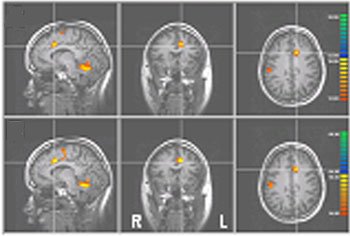Training your brain to feel less pain
People can ease pain by using their minds to reduce activity in a certain brain area.
By Emily Sohn
Your brain controls your body, and your body affects your brain. Now, scientists have found a way to turn the system upside down.
With practice, a new study suggests, people can use their minds to change the way their brains affect their bodies. In particular, by watching activity in a brain scan, people can train their brains to process pain differently and reduce the amount of pain that they feel.
 |
|
By watching activity in a brain scan, people can train their brains to process pain differently and reduce the amount of pain that they feel. The image of a flame on the left represents a low level of activity in a certain region of the brain, and the one on the right shows a high level of brain activity in the same region. |
| Proceedings of the National Academy of Sciences |
The researchers worked with 32 healthy volunteers, ages 18 to 37. To begin with, volunteers received a heat pulse to their legs. The heat pulses could vary in intensity. On a scale from one to 10 (with 10 being “the worst pain imaginable”), they had to report when the intensity of the pain that they felt was higher than 7.
Using a brain-scanning machine called an fMRI scanner, the scientists were able to see that this level of pain sparked a lot of activity in a part of the brain called the rostral anterior cingulate cortex.
Next, eight of the volunteers went through brain training. Scientists hooked them up to machines that allowed them to see what was going on in their own rostral anterior cingulate cortexes. An image of a flame grew when there was a lot of activity there and shrank when there was less.
After 39 minutes of practice, the researchers found, volunteers were able to control the size of the flame and, hence, their pain levels, even with the same intensity of heat on their legs. Mental exercises, such as thinking about something besides the pain, seemed to help.
The other 24 volunteers were also told to try to change the activity level in their rostral anterior cingulate cortexes, but they didn’t get to see what was happening there. Sometimes, they were able to see brain activity in other parts of their brains or brain activity in other people’s brains. Without direct feedback, though, they were unable to change the level of activity in the correct part of the brain or the amount of pain that they felt from the heat.
 |
|
These fMRI brain scans show various levels of activity (colors) in a part of the brain called the rostral anterior cingulate cortex.
|
| Proceedings of the National Academy of Sciences |
In the final stages of their study, the scientists gave this type of brain training to eight people who suffer from chronic pain, which means they have recurring pain much of the time that gets in the way of their lives. By the end of the experiment, all of the patients reported feeling less pain when activity in the rostral anterior cingulate cortex went down. Chronic-pain patients who practiced doing other types of feedback didn’t gain the same benefits.
Scientists have been struggling to understand pain for a long time. This new research might help improve the lives of people who have to live with it.—E. Sohn
Going Deeper:
Bower, Bruce. 2005. Brain training puts big hurt on intense pain: Volunteers learn to translate imaging data into neural-control tool. Science News 168(Dec. 17):390. Available at http://www.sciencenews.org/articles/20051217/fob5.asp .
You can learn more about the pain research of Sean Mackey at Stanford University at mednews.stanford.edu/releases/2005/december/pain.html, paincenter.stanford.edu/research/index.html, and paincenter.stanford.edu/research/rtfmristudy.html (Stanford University School of Medicine).







